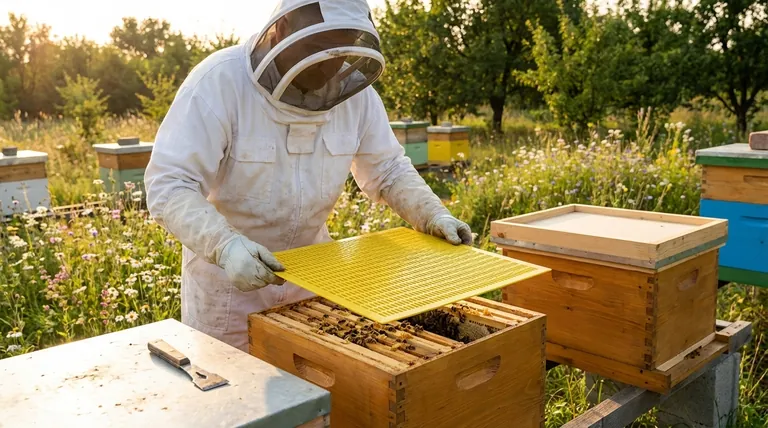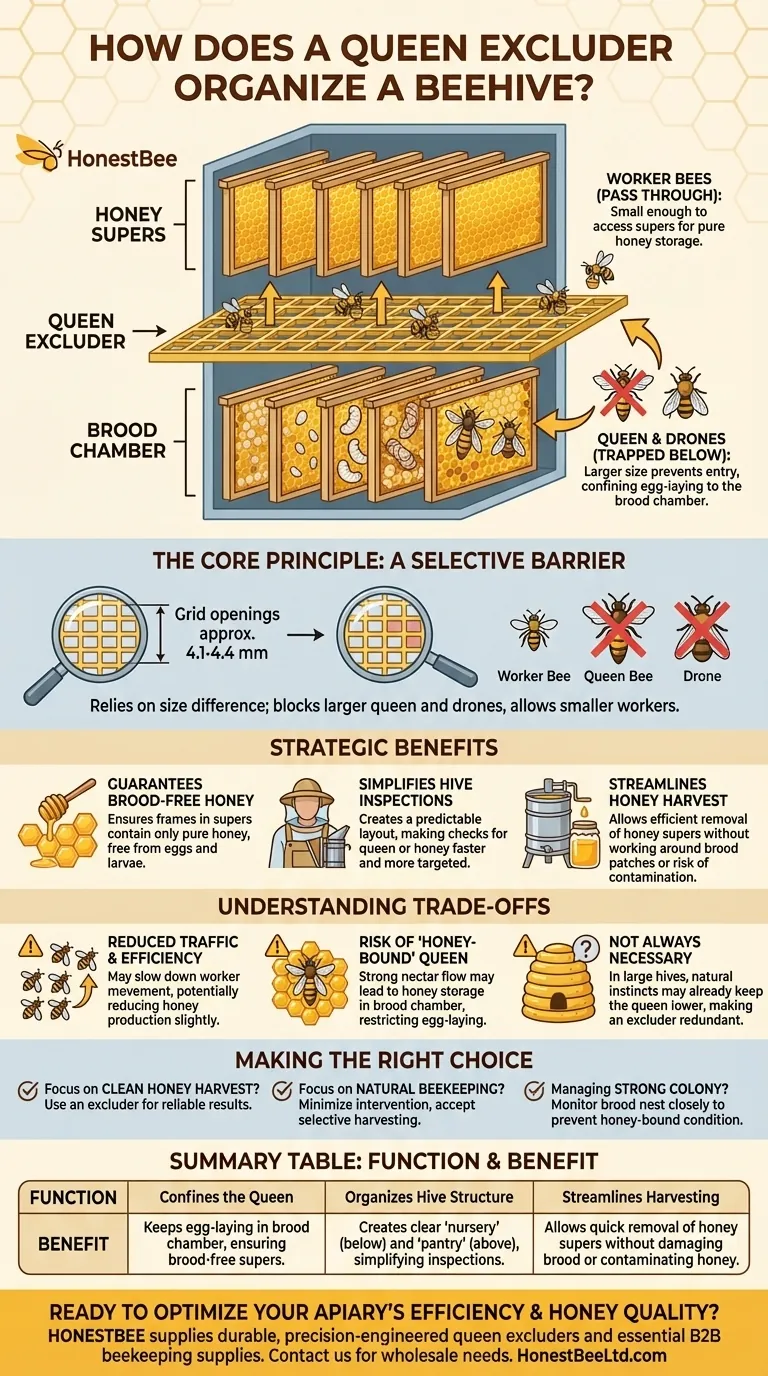A queen excluder organizes a beehive by acting as a selective barrier. It is a grid placed between the hive's brood chamber and the honey storage boxes (supers), with openings large enough for worker bees to pass through but too small for the larger queen. This confines the queen and her egg-laying to the lower section of the hive, dedicating the upper supers exclusively to clean, brood-free honey.
The core purpose of a queen excluder is not to organize the bees themselves, but to organize the hive's structure for the beekeeper. It creates a clear separation between the nursery and the pantry, which dramatically simplifies hive management and honey harvesting.

The Core Principle: A Selective Barrier
A queen excluder's function is elegantly simple, relying entirely on the size difference between bees. Understanding how it works is key to using it effectively.
What Is a Queen Excluder?
A queen excluder is a flat rack, typically made of metal or plastic, with precisely sized perforations or wires.
This grid is designed to be placed between hive boxes like a screen.
How It Works: Size Matters
The openings in the excluder are engineered to be approximately 4.1 to 4.4 millimeters.
Worker bees are small enough to easily pass through these gaps to access the honey supers above. However, the queen bee and male drones have larger thoraxes and cannot fit through, effectively trapping them in the box below the excluder.
Proper Placement is Crucial
The excluder is installed directly on top of the uppermost brood chamber—the box where the queen is actively laying eggs.
The honey supers are then placed on top of the excluder. This ensures any box above the excluder will be used by workers for honey storage only.
The Strategic Benefits of Hive Separation
By controlling the queen's movement, a beekeeper gains significant advantages in managing the colony and its resources.
Guaranteeing Brood-Free Honey
This is the primary benefit. When the queen cannot access the honey supers, she cannot lay eggs in the honeycomb.
This results in frames filled with pure honey, free from eggs, larvae, and pupae. This honey is cleaner, easier to process, and often considered higher quality.
Simplifying Hive Inspections
An excluder creates a predictable hive layout. The beekeeper knows with certainty that the brood nest is below the excluder and pure honey is above it.
This makes inspections faster and more targeted. If you need to check on the queen's laying pattern, you only need to look in the bottom boxes.
Streamlining the Honey Harvest
Harvesting honey is far more efficient when you don't have to work around patches of brood.
You can remove entire boxes of honey supers at once without the risk of damaging developing bees or contaminating the honey with "brood juice" during extraction.
Understanding the Trade-offs
While effective, queen excluders are a subject of debate among beekeepers, and their use involves potential downsides.
Reduced Traffic and Efficiency
Some beekeepers believe the barrier, while passable, can slow down worker bees. The constant need to squeeze through the grid may cause minor wear on their wings over time.
This potential "traffic jam" can, in some cases, lead to slightly lower honey production compared to an unrestricted hive.
The Risk of a "Honey-Bound" Queen
If a strong nectar flow is underway, worker bees may be reluctant to cross the excluder and begin storing honey in the brood chamber instead.
This can fill cells the queen needs for egg-laying, a condition known as being honey-bound. This restricts colony growth and must be managed by the beekeeper.
Not Always Necessary
In very large hives with multiple deep brood boxes, the queen often prefers to stay in the lower sections naturally.
In these scenarios, the colony's own instincts create the desired separation, and adding a mechanical excluder may be redundant.
Making the Right Choice for Your Goal
The decision to use a queen excluder depends entirely on your beekeeping philosophy and objectives.
- If your primary focus is a straightforward, clean honey harvest: Using an excluder is the most reliable method to ensure your honey supers contain nothing but honey.
- If your primary focus is minimal intervention or "natural" beekeeping: You may prefer to let the bees manage their own space, accepting that you will need to be more selective when choosing frames to harvest.
- If you are managing an exceptionally strong colony: You must be vigilant in monitoring the brood nest to ensure the queen has ample space to lay, preventing the hive from becoming honey-bound.
Ultimately, the queen excluder is a powerful tool that gives the beekeeper precise control over the hive's internal architecture for a more predictable and efficient harvest.
Summary Table:
| Function | Benefit for the Beekeeper |
|---|---|
| Confines the Queen | Keeps egg-laying in the brood chamber, ensuring brood-free honey supers. |
| Organizes Hive Structure | Creates a clear "nursery" (below) and "pantry" (above), simplifying inspections. |
| Streamlines Harvesting | Allows for quick removal of honey supers without damaging brood or contaminating honey. |
Ready to optimize your apiary's efficiency and honey quality?
HONESTBEE supplies durable, precision-engineered queen excluders and other essential beekeeping supplies to commercial apiaries and beekeeping equipment distributors. Our wholesale-focused operations ensure you get the reliable equipment you need to manage your hives effectively and maximize your harvest.
Contact HONESTBEE today to discuss your wholesale needs and discover how our equipment can benefit your operation.
Visual Guide

Related Products
- Professional Plastic Queen Excluder for Modern Beekeeping
- Wooden Queen Bee Excluder for Beekeeping
- Premium Wood Framed Metal Wire Queen Bee Excluder
- High Performance Plastic Queen Excluder for Beekeeping and Apiary Management
- Plastic Queen Bee Excluder for Bee Hive Wholesale
People Also Ask
- How does a queen excluder work? Master Hive Management for Pure Honey Harvests
- What are the main advantages of using a queen excluder in beekeeping? Simplify Hive Management & Harvest
- How do queen excluders work in terms of spacing and bee movement? A Guide to Precision Hive Management
- What are the pros of using queen excluders? Boost Honey Production & Hive Efficiency
- What is the purpose of a queen excluder when adding a super? Streamline Your Honey Harvest



















